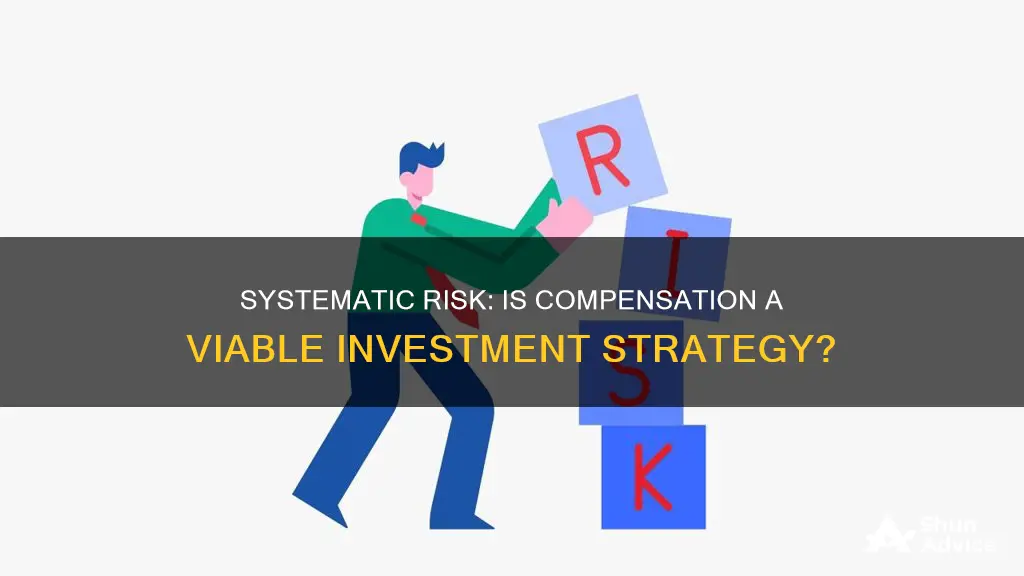
Investors are compensated for taking systematic risk because it cannot be diversified. Systematic risks are non-diversifiable risks that impact the entire market, such as inflation, war, recessions, and geopolitical or macroeconomic trends. These risks are priced into the expected returns of risky assets, making them more attractive to investors. If investors were not compensated for taking on systematic risk, they would simply choose lower-risk assets with similar returns.
| Characteristics | Values |
|---|---|
| Compensated risks | Expected returns |
| Uncompensated risks | Idiosyncratic risks |
| Systematic risks | Inflation, war, recessions, and other geopolitical or macroeconomic trends |
| Idiosyncratic risks | Risks that are particular to a stock or a sector of the economy |
What You'll Learn

Systematic risk is non-diversifiable
Because systematic risk cannot be diversified away, investors who take it on must be compensated through higher expected returns. If there were no higher expected returns, investors would simply choose to invest in lower-risk assets. As a result, the price of risky assets falls until investors no longer have a preference between risky and lower-risk assets. This is known as the compensation for systematic risk.
It is important to note that the compensation for systematic risk is just a theory and may not always hold true in the real world. Additionally, people's tendency to use risky stocks for gambling drives their prices up and makes them more expensive, resulting in even lower expected returns than what the theory would predict.
In contrast, unsystematic or idiosyncratic risk can be diversified away. This type of risk is specific to a particular stock, sector, or country. By diversifying across different stocks, sectors, or countries, investors can reduce their exposure to unsystematic risk while still achieving the same expected returns. Therefore, unsystematic risk is considered uncompensated.
Cash Offers for Investment Houses: Pros and Cons
You may want to see also

Systematic risks include pandemics, geopolitical crises, inflation, climate change, etc
Systematic risks are those that affect the market as a whole and cannot be avoided or mitigated through diversification. Examples include economic downturns, political instability, regulatory changes, natural disasters, and pandemics. These events can have far-reaching impacts on the economy and financial markets, affecting a wide range of industries and sectors.
The COVID-19 pandemic, for instance,
Clo Managers: Investing in Their Own Success?
You may want to see also

Systematic risks affect the entire market
Systematic risks are non-diversifiable risks that affect the entire market. They include events such as pandemics, geopolitical crises, inflation, climate change, and other macroeconomic trends. These risks cannot be mitigated through diversification strategies because they impact a broad range of securities across the market. As a result, investors who take on systematic risks expect to be compensated with higher returns.
In contrast, unsystematic or idiosyncratic risks are specific to individual companies, industries, or sectors. These risks arise from factors such as management decisions, legal issues, or technological changes and can be mitigated through diversification. By investing in multiple companies or sectors, investors can reduce the impact of unsystematic risks on their portfolios.
The distinction between systematic and unsystematic risks is crucial in modern portfolio theory. Investors who take on systematic risks are exposed to market-level phenomena and demand higher returns as compensation. On the other hand, unsystematic risks can be diversified away, and therefore, they are not compensated in the same way.
While systematic risks cannot be avoided, investors can take a systems-level approach to investing, which involves considering the impact of corporate externalities on financial, social, and environmental systems. This approach aims to influence enterprise risk and return, with a focus on the long-term resilience of capital markets. By integrating a systems lens into their analysis, investors can make more informed decisions and potentially improve the resilience of their portfolios.
Debt Investment Portfolio: Understanding Your Debt Investments
You may want to see also

Systematic risks are measured by beta
Systematic risk is the risk that applies to the entire market and cannot be diversified away. It includes risk factors that affect the market as a whole, such as interest rates, economic cycles, natural disasters/pandemics, currency fluctuations, and inflation. This type of risk is difficult to predict and hedge against.
Beta is a measure of the relationship between the rate of return of a company's stock and the overall market return. It compares the volatility of a stock relative to that of the market. Beta indicates how a stock's value has reacted or is expected to react to movements in the market.
Beta is a theoretical measure of systematic risk. It is calculated by dividing the covariance of a security's returns and the market's returns by the variance of the market's returns over a specified period. Beta is also used in the Capital Asset Pricing Model (CAPM) to calculate the cost of equity of an asset.
A beta of 1 indicates that a stock moves with the market. A beta greater than 1 indicates that a stock is more volatile than the market and has a higher systematic risk. This means that the stock will likely give higher returns than the benchmark index when the market is performing well, and greater losses when the market is performing poorly. Conversely, a beta of less than 1 indicates that a stock is less volatile than the market.
Beta can be calculated through regression analysis, which is the most common and practical method for estimating beta for listed companies. It can also be calculated by running a linear regression on a stock's returns compared to the market using the CAPM.
Our Social Security Savings: Where Are They Invested?
You may want to see also

Active investment strategies attempt to beat the market
Active investors are flexible and can adjust portfolio allocations in response to changing market conditions or economic outlooks. This type of investment strategy can take advantage of emerging trends or macroeconomic shifts by reallocating assets to potentially boost returns, mitigate downside risk, and preserve capital during volatile market environments more effectively.
The appeal of active investing is that it offers the opportunity to beat the market. In any given year, some stocks and actively-managed funds will outperform the market average. However, it is nearly impossible to beat the market consistently over the long term. Active investing also has higher total costs due to research costs, trading costs, and taxes, which reduce net returns. It is also riskier, as investing in a single stock or small concentration of stocks adds "specific" risk beyond what would be assumed by investing in the stock market, without a corresponding increase in expected return.
Passive investing, on the other hand, does not attempt to predict which investments will outperform the average. It aims to capture the long-term appreciation of the market while reducing costs and minimizing the additional risk associated with investing in individual stocks or specific market sectors. Passive investors invest in passively managed funds that represent the makeup of the stock market or a subset of it, resulting in a portfolio performance almost identical to the market's performance. Passive investing is more cost-effective, as these funds aim to replicate the performance of an index rather than outperform it, leading to lower management fees and transaction costs. Most passive investors follow a buy-and-hold strategy, further reducing transaction costs.
Ultimately, the choice between active and passive investing depends on an investor's circumstances, preferences, and investment objectives. Those with a competitive streak or a high tolerance for risk may be drawn to the potential for higher returns offered by active management. However, passive investing is typically a better strategy for those investing for the long haul, as it is challenging to beat the market consistently, and the extra costs and risks associated with active management can offset gains.
Invest in US Equities: A Smart, Stable Choice
You may want to see also
Frequently asked questions
Systematic risks are non-diversifiable risks that impact the entire market, such as inflation, war, recessions, and other geopolitical or macroeconomic trends. Unsystematic risks are specific to a company, industry, or sector, and can be mitigated through diversification.
Systematic risks cannot be avoided or diversified away, so investors need to be compensated for accepting them. The compensation comes in the form of positive expected returns in excess of the risk-free rate.
Systematic risks are compensated through higher expected returns. If a stock is considered risky, it will sell for less than its expected future value, so the buyer is compensated for holding it.
One example of a systematic risk is climate change, which will impact all companies and sectors to varying degrees. Investors are compensated for this risk through higher expected returns.
While systematic risks cannot be completely eliminated, investors can reduce their exposure by adopting a systems-level approach to investing. This involves considering the externalities and feedback loops that impact entire economic systems, rather than just individual companies or sectors.







